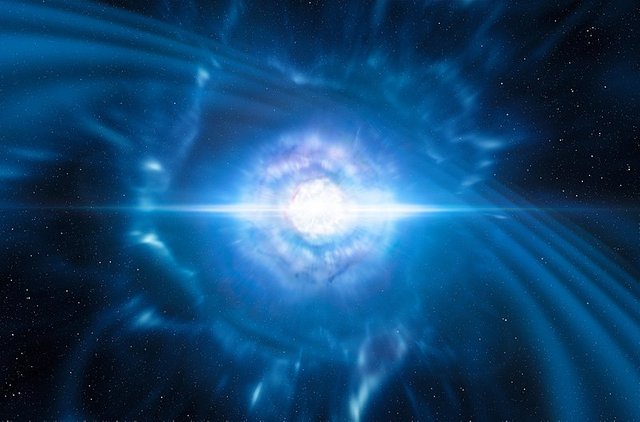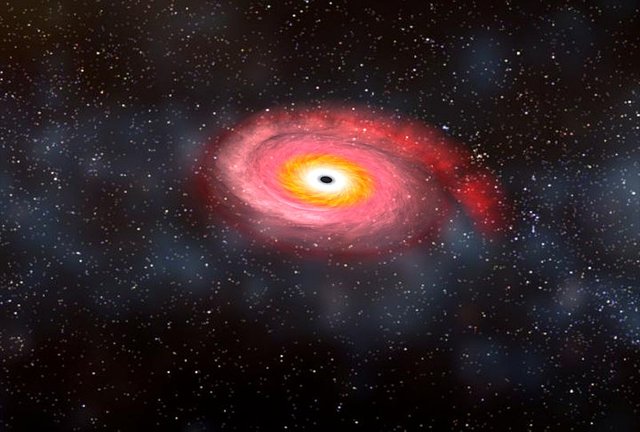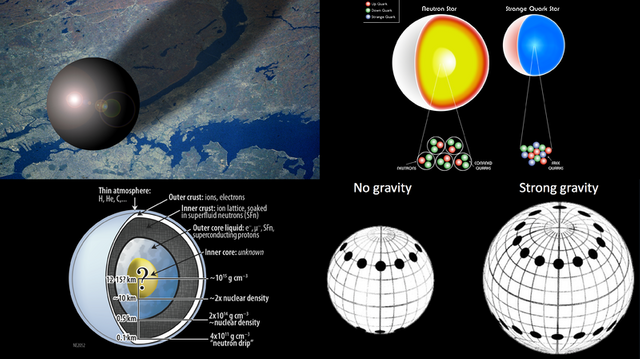Neutron Stars.
The Neutron Star is formed as a result of a supernova explosion in the late stages of star evolution. It is star with a mass greater than 10 solar masses. At the end of its evolution, produces an iron core in the size of the Earth in which fusion reactions can no longer take place. The electrons then move at a speed almost equal to the speed of light. Neutron Stars are some of the most strange things in the Universe. Unbelievable dense and violent.

The life of a star is dominated by two forces being in balance. Its own gravity and the fusion radiation pressure. In the core of stars hydrogen is fused into helium. Eventually, the hydrogen in the core is exhausted. After that helium is fused into carbon which depends on the mass of the star. Cores of the massive stars become layered like onions, as heavier atomic nuclei build up at the center. When the fusion stops, the radiation pressure drops rapidly. Then the star balance is drastically disturbed and if its core mass exceeds abou 1.4 solar masses, a catastrophic collapse takes place.
The pressure of the accelerated electrons balances the gravitational force of attracting dense matter. But with sufficiently high energy of electrons, they combine with protons to form neutrons. The pressure then decreases, the gravitational interaction takes over and in less than a second the core collapses and turns into a neutron star. Part of the energy released at the same time is transferred to the matter surrounding the core, which at a speed of several thousand kilometers per second is diverging in space. The whole phenomenon, seen from a distance as a violent flare of the star, is called the type II supernova.
So now we have neutron star.
It's mass is between 1 and 3 Suns, but compressed to an object about 25 kilometers wide. If the remains of the explosion are more massive, a black hole is created. Neutron stars are for us the last source of information about the most extreme and yet available observation of the state of matter in the Universe. It is estimated that every thousandth star in our Galaxy is a neutron star.

Neutron stars have also very specyfic gravity. For example if we would drop object on its surface from short distance it would accelerate up to about 7 million km/h in a few microseconds. Its atmosphere is very thin, filled with hot plasma and its surface temperature reaches up to 1 million Kelvin.
The crust of Neutron star is extremely hard and probably made of an iron atom nuclei lattice with electrons flowing through them. Closer to the core the amount of neutrons is increased and protons decreased. Going further we can observe dense group of indistinguishable neutrons. The core of the star is very specific and we still do not have accurate data to estimate its composition and specifications.

During the neutron star formation, the radius decreases. From the principle of conservation momentum is due to the fact that then there is an increase in the spin speed of the star. The rotation period can range from a fraction of a second to a few seconds. We call these objects pulsars and its shape is rather distorted due to the high speed it moves. The rotation of pulsars causes the generation of strong radio radiation. This is caused by plasma movement and changes in the magnetic field. Magnetic field of neutron star is 8 trillion times stronger than the magnetic field of Earth. So strong that atoms get bent when they enter its influence.
References:
[1] http://www.astrouw.edu.pl/~mj/Fizycy/A05.pdf
[2] http://uranos.cto.us.edu.pl/~manka/gwiazdy.pdf
[3] http://fizyka.net.pl/astronomia/astronomia_oa5.html